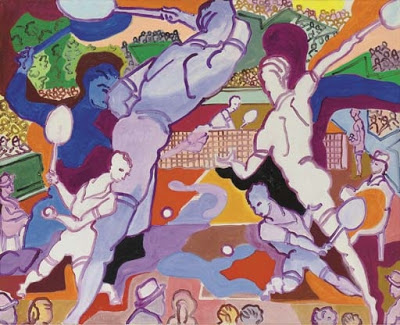by Nina
 |
| Le Tennis by Charles Lapicque |
Agility is the ability to move easily through a series of positions while you stay balanced and in control. Everyday situations that require agility include getting in and out of a car (especially the back seat of a two-door!) and getting up and down from the floor. Often speed is required as well as coordination, such as when you walk down a crowded city sidewalk (have you ever been to New York City?) or scoop up a ball that’s rolling along the ground. For those of you who play sports, such as tennis, basketball, and soccer, maintaining agility will enhance your performance. Maintaining agility also helps prevent falls, a serious—sometimes life-threatening—problem for older people.
So even though we tend to think just about maintaining the ability to “balance” as we age, staying agile can be just as important both for our safety and for being able to continue to do what we love, whether that’s participating in a sport, hiking in nature, or walking through the streets of a crowded city. So today I thought I’d provide an overview of what agility entails along with a list of the sequences on our blog that can that you can use to maintain and/or improve your agility.
About Agility
Being agile and coordinated requires a combination of a number of physical and mental skills. First of all, to move with ease, you need all three of the other essential skills that I hope you’re already working on: strength, flexibility, and balance. And, importantly, to stay upright as you move from one position to another, the same postural reflexes that help you balance upright in static poses also help you stay upright when you’re moving from one position to another.
Exteroception and Proprioception. The ability to make coordinated, precise movements comes from combining the three essential physical skills with knowing where you are in space. As we described in How We Balance, exteroception, the ability to feel what is interacting with the exterior of your body, and proprioception, the ability to tell where one body part is in relation to another, both allow you to maintain your balance in a static position. These same senses allow you to maintain your balance and sense of where your body is in space as you move from one position to another, so both are as important for agility as they are for balance.
Vision, Hearing, and Touch. Whether you are walking down a crowded sidewalk your during lunch hour, hiking a mountain path, or doing Sun Salutations in a crowded classroom, you also need your eyes, ears, and sense of touch to tell you where you are in space, and to provide you with information about possible obstacles and your relationship to them. Is that someone riding a skateboard behind me? Is that a slippery rock in the middle of the path over there? Should I step back a bit so I don’t hit that person next to me when I bring my arms out to the sides? Or—oops—did I already do it?
Focus. Unless you’re doing a series of movements that have become automatic, your ability to concentrate as you move from one position to another is a very important aspect of agility. Becoming distracted can throw you off balance or cause you to run into an obstacle. Let’s say you’re at a music festival weaving your way through the obstacle course of other people trying to find good spot, blankets, chairs, and coolers set up by people already dug in, and toddlers bolting off in random directions. If you stopped looking where you’re going or paying attention to where your feet were taking you, just imagine!
And even for a routine set of movements, such as Sun Salutations, some amount of mental focus is needed, as complete distraction causes you to lose track of where you are or suddenly find yourself doing the wrong thing (been there, done that).
Speed. For those times when you need to respond quickly as well as with coordinated movement, your strength is particularly important. Because the fast-twitch muscle fibers in your muscles affect the speed and explosiveness of your muscle contractions, strong muscles provide you with both power and velocity. But moving with speed on a regular basis will also prepare you for those situations when being agile means responding rapidly. In addition, a healthy somatic nervous system—the part of your nervous system that provides you with voluntary control of your body movements—is important for quick, coordinated responses to your requests for movement. When you think, “step forward right foot,” you want fast results!
How Yoga Helps
A well-rounded yoga practice that cultivates strength, flexibility, and balance will also enhance your agility. But yoga enables you to work directly on the coordination and speed aspects of agility with the following:
Dynamic Poses and Flow Sequences. Moving dynamically in and out of poses with your breath or between linked poses in flow sequences allows you to practice quick, precise movements. This improves your overall coordination, and exercises the fast-twitch fibers that assist in quick movements. The wide range of dynamic poses and flow sequences that you can choose from (and the ability to make up new ones!) provides you with enough variability to address virtually all your muscles and to stay challenged.
Static Poses. Moving in and out of static poses with precision helps improve coordination. And making subtle adjustments to your alignment while you’re in a pose refines your ability to sense where you are in space and improves fine motor control (as you start to use rarely used muscles). The large repertoire of yoga poses plus their many variations means you can use virtually all your muscles—in many different ways—throughout a given week, rather just doing the same basic movements over and over.
To maintain your fast-twitch fibers, you can focus on strength-building practices in static poses, particularly standing poses that mimic getting up and down. And practicing all types of balance poses, especially using the challenge techniques we recommend, such as varying the surface you practice on and practicing standing poses with closed eyes, will also help maintain fast-twitch fibers as well as postural reflexes.
Floor Poses. Getting up and down from the floor on a regular basis helps you maintain agility (and it’s one of the things you need agility for!). So just the act of adding floor poses to your practice is beneficial, even if you have to use support to get up and down.
Mindfulness. For all poses, practicing mindfully engages and refines your senses. For vision, you use your eyes to verify your alignment. Are your feet evenly aligned on the floor or is your foot really turned out? For hearing, you use your ears to note how gracefully or awkwardly you make certain movements—when you step into a new position, are you coming down lightly or heavily? For your sense of touch, you can observe how evenly you are pressing into the floor or onto a prop, and notice when one part of your body is touching another (sometimes that means you’re doing the pose right and other times—oops!).
Nerve Health. To maintain speed, you can use your asana practice to support the health of your somatic nervous system. Practicing a wide variety of poses and movement patterns will activate all those nerves on a regular basis. Active poses will improve blood flow to your special sensory nerve receptors (the nerves that shuttle information back to the brain) and stretching poses will create space around your nerves. Finally, balancing poses and flow sequences will help keep your proprioceptors—the nerves that allow you to sense where you are in space—healthy.
Mental Focus. Moving through flow sequences trains your mind as you return your focus again and again to making quick, precise movements while maintaining balance. You notice shifting sensations—the feeling of being on or off balance—and when extraneous thoughts take you away from your movements. In addition, breath practices and meditation can improve your mental focus in general, benefitting your balance both inside and outside the yoga room.
Cognitive Distraction. When you’re ready for more advanced challenges, you can prepare for real-world situations by adding cognitive distraction to your agility practices. Although you can’t toss a ball from hand to hand while practice a flow sequence, you can play music or talk radio, or have some pets or small children—watch out!—join you in the yoga room.
Practices for Agility
Although we only have two sequences on our blog that were designed specifically for cultivating agility, I’ve found several others that can also be helpful because they involve moving in and out of poses with your breath. So if the full-length sequences are too long or too challenging, check out the list of various mini and full Sun Salutations. For general information about how to practice for cultivating agility, including which types of poses to practice and how often to practice, see Techniques for Cultivating Agility.
Here are the two agility practices Baxter designed with my help:
Featured Sequence: Agility Practice
Featured Sequence: Challenging Agility Practice
Here are a wide range of Sun Salutations, from easy and accessible to the classic challenging version.
Wall Sun Salutations is designed by Jivana Heyman to provide an easier, supported way of moving in and out of the Sun Salutations with your breath.
Featured Sequence: Mini Sun Salutations is a shorter version of the classic Sun Salutation that excludes the Plank pose and Upward-Facing Dog.
Full Catastrophe Sun Salutations is Beth’s custom Sun Salutation that addresses the complexity of living life as a yogi amid the tangles of today’s world.
Featured Sequence: Mini Sun Salutations with Fig Leaf Forward Bend is a modified version of a Sun Salutation that uses our Fig Leaf Forward Fold pose to begin and end each round. Practicing Sun Salutations with this modification may be safer for some of you with lower back problems.
Video of the Week: Sun Salutations with Cobra Pose is Baxter’s version of the Sun Salutation with Cobra pose instead of Upward-Facing Dog.
Video of the Week: Sun Salutations with Upward-Facing Dog is Baxter’s version of the classic Sun Salutation with the more challenging Upward-Facing Dog rather than Cobra pose.
Follow Yoga for Healthy Aging on Facebook ° To order Yoga for Healthy Aging: A Guide to Lifelong Well-Being, go to Amazon, Shambhala, Indie Bound or your local bookstore.


Thanks for this article! Unfortunately I found that the links for the Wall Sun Salutations and the Full Catastrophe Sun Salutations did not work.